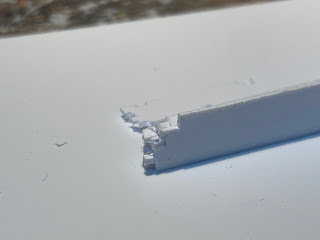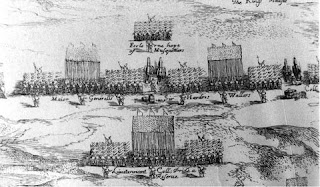Wednesday, 8 May 2024
Backs (or flank) against the wall, Heavenfield, 633 CE
Friday, 2 September 2022
Split rail fences for 2mm ACW
Felling the timber, splitting it into rails and stacking it along your farm boundaries must have been a punishing task in the 19th century.
Punishing, in a very different way, is an apt description for scratch building split rail (snake) fencing for my 1:800 (eg. 2mm) ACW terrain!
I have to admit these little guys spent more time stuck to my fingers than to their bases. Nevertheless, the struggle yielded the equivalent of 14 chains (chain = 22 yards) of fencing for Wilmer McLean’s farm.
The method, while fiddly, is fairly strait forward.
I cut a series of 50mm x 1mm strips (sorry, back to metric for this) of 0.5mm Evergreen Styrene sheet which was scored every 5mm on opposite sides.
I then bent each scored point to form a zigzag long enough for my bases. This was attached to the base (via being glued to various fingertips) using Superglue. Then 5mm lengths were scored in the centre and bent into a right angle piece using tweezers. These were glued to the outward facing points of the fence to represent the crossed over rails.
The roughed up 45mm x 10mm base of styrene was coated carefully with fine sand (using PVA) and then undercoated with Vallejo grey primer (73.601). I washed the dry undercoat with Liquitex raw umber acrylic ink. Then, I painted the fence rails dark brown. These were dry-brushed with Army Painter Drake Tooth. My flower meadow mix of flocking was glued in place then a light coat of Vallejo Mecha Dark Rust wash (a staple in my paint collection) was applied on the rails. Done!
These simple 2mm terrain pieces add, I feel, some period flair to ACW battlefields at this scale. Maybe cornfields and a peach orchard next!
Saturday, 28 September 2019
2mm ACW (with updates)
Update: I have since discovered that the rules are part of a collected set by John Bobek, The Games of War: A Treasury of Rules for Battles with Toy Soldiers, Ships and Planes (2007): https://boardgamegeek.com/boardgame/37718/games-war-treasury-rules-battles-toy-soldiers-ship A copy is on its way in the next week or two! I will review the rules in more detail then.
The mechanics of movement, shooting, melee and morale are provided but the set lacks a turn sequence and the morale rules are a bit unclear - but the rest is solid. I’m playing through a game to the identify gaps and will write up some homegrown solutions.
Update: thanks for a Review by Ryan Morgan on the above BGG page, I have learned that 'In chapter one Mr. Bobek lays out the ground work for interpreting his rules in the further chapters as well as discusses his philosophy for wargaming.'
At this point I just wanted to post some shots of the initial few turns and I will update on my thoughts soon. This blog has been quiet for too long!
I’ve also been experimenting with creating woods terrain for 2mm using Casuarina cones coated in flock - there are some WIP images below. I'll post a short tutorial next.
Sunday, 1 April 2018
Thirty Years War in 2mm - basing using 17th century military texts
For instance, for the 2mm enthusiast I thoroughly recommend a wander around Sydney Roundwood's blog (Roundwood's World) and check out his wonderful Lützen (1632) and Nördlingen (1634) projects in 2mm. I liked the result so much, I have shamelessly copied the winter basing Sydney has used. After all, Imitation is the sincerest form of flattery that mediocrity can pay to greatness!
 |
| What I love about 2mm as a scale, one small bag contains a few weekends of work! |
 |
| Hmmmm. So, what to do with them... |
 While in many cases the deployments of foot troops discussed in these manuals tend towards the theoretical rather than actually reflecting those used in the field, it helped me better understand the texts and posed interesting challenges in working with the blocks and the space available on the base.
While in many cases the deployments of foot troops discussed in these manuals tend towards the theoretical rather than actually reflecting those used in the field, it helped me better understand the texts and posed interesting challenges in working with the blocks and the space available on the base.Overall, the main Irregular Miniatures blocks I used for these bases were:
- RBG7, 45 figure 1-2 pike/shot unit (15 pike/30 shot);
- RBG12, 3-rank Forlorn Hope - 15 figures;
- RBG33, 15 figure Pike block;
- RBG25 Command - 2 figures;
- RBG9, Swiss/Landsknecht pike unit (40 pikes);
- BG2, Infantry in three ranks (24 figures) (these are from the Horse and Musket range; but make great musket units);
- Oh, and of course, the Tercio! - RBG10, Tercio (100 figures 40 pike/60 shot).
My basing scheme is using a 50mm x 25mm bases (c. 2"x1") for foot and cavalry with each foot base being a regiment and each cavalry base a squadron. Command and artillery (and possibly detachments of shot) will be on 25 x 25mm (c. 1" x 1") bases. So, basically, a scaled down Polemos basing system.
 |
| All three squadrons deployed in the style of the Swedish Brigade. |
Wednesday, 14 March 2018
Fields of Blue & Grey - 2mm ACW AAR
Abbott's rules seek to emphasise command and control game mechanics. Brigades are given orders by Division (and Corps) commanders at the beginning of the game and these can be changed under certain conditions. Brigade commanders can also request an order change by sending a messenger with a status report to his superior.
The combat mechanism is fairly simple based around opposing d6 rolls modified by the presence of leaders, terrain, the level of fatigue of the brigade and morale. Combat losses are essentially reflected by a build-up of fatigue at the Brigade level each time a regiment is in action. As the fatigue level of the Brigade increases it can effect the combat factor of the unit (called its 'volume of fire') and the morale status.
I used an older version of the rules (attached as a PDF at the bottom of the page linked to above) win which Brigades (and divisions) must pass a morale test every turn. A 2012 update moves away form Brigade and Division morale checks. Instead, the units fatigue and morale impact on the brigade's capacity to activate each turn.
Overall, I feel the first use of these rules gave an interesting game and I really liked the 'orders' mechanism and the inevitable consequence of the build up of fatigue. The impact of sustained combat on brigades is well modeled by the fatigue rules - a nice touch. I felt it gave quite a good 'feel' for the challenges faced by brigade and divisional commanders during the Civil War.
As a first time player, I did find the occasional situation where the rules were not explicit. For example, it was not clear on the difference between mounted an dismounted cavalry (except a reduction in movement for dismounted).
One of the difficulties I had was around understanding the impact of varying morale levels (disordered, shaken, beaten) on game play. Again, I believe this is addressed by the new activation system. There was a bit of record keeping (orders, morale status, commander ability and troop quality) but with a little planning and some more subtle on-board counters and a simple roster sheet, it would be handled easily.
 |
| Brigadier General Tyndale's Brigade deployed in line of battle with a small reserve and his right flank holding the heights. |
 |
| From the SE, elements of Anderson's Brigade pursue the remnants of a Union division that fell back after an action that earlier that morning. |
 |
| The Confederates deploy into line. The final advance begins. |
 |
| Tyndale's Brigade have rifled muskets so get the first volley in as the Confederates close on their line. |
 |
| The Union troops are spooked as the Rebs advance and their musketry has little impact. |
 |
| The musketry of the Confederate left flank finds its mark and the forced a Regiment back over the crest of the hill. On the Union left, the artillery unlimbers at the foot of the hill. |
 |
| The last remaining Union regiment has to fall back under sustained fire from the Confederates. |
 |
| The Union cavalry assault on the left fails. The Union morale falls again - Tyndale's Brigade is battered! |














































